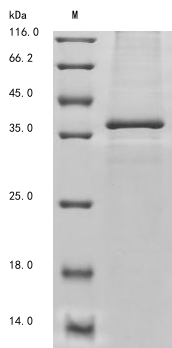Recombinant Human Deoxyribonuclease gamma (DNASE1L3)
CAT:
399-CSB-BP621686HUb1-03
Size:
20 µg
Price:
Ask
- Availability: 24/48H Stock Items & 2 to 6 Weeks non Stock Items.
- Dry Ice Shipment: No




Recombinant Human Deoxyribonuclease gamma (DNASE1L3)
- CAS Number: 9000-83-3
- Gene Name: DNASE1L3
- UniProt: Q13609
- Expression Region: 21-305aa
- Organism: Homo sapiens
- Target Sequence: MRICSFNVRSFGESKQEDKNAMDVIVKVIKRCDIILVMEIKDSNNRICPILMEKLNRNSRRGITYNYVISSRLGRNTYKEQYAFLYKEKLVSVKRSYHYHDYQDGDADVFSREPFVVWFQSPHTAVKDFVIIPLHTTPETSVKEIDELVEVYTDVKHRWKAENFIFMGDFNAGCSYVPKKAWKNIRLRTDPRFVWLIGDQEDTTVKKSTNCAYDRIVLRGQEIVSSVVPKSNSVFDFQKAYKLTEEEALDVSDHFPVEFKLQSSRAFTNSKKSVTLRKKTKSKRS
- Tag: N-terminal 10xHis-tagged and C-terminal Myc-tagged
- Source: Baculovirus
- Field of Research: Cancer
- Assay Type: In Stock Protein
- Relevance: Has DNA hydrolytic activity. Is capable of both single- and double-stranded DNA cleavage, producing DNA fragments with 3'-OH ends . Can cleave chromatin to nucleosomal units and cleaves nucleosomal and liposome-coated DNA . Acts in internucleosomal DNA fragmentation during apoptosis and necrosis . The role in apoptosis includes myogenic and neuronal differentiation, and BCR-mediated clonal deletion of self-reactive B cells . Is active on chromatin in apoptotic cell-derived membrane-coated microparticles and thus suppresses anti-DNA autoimmunity . Together with DNASE1, plays a key role in degrading neutrophil extracellular traps. NETs are mainly composed of DNA fibers and are released by neutrophils to bind pathogens during inflammation . Degradation of intravascular NETs by DNASE1 and DNASE1L3 is required to prevent formation of clots that obstruct blood vessels and cause organ damage following inflammation.
- Purity: Greater than 85% as determined by SDS-PAGE.
- Activity: Not Test
- Length: Full Length
- Form: Liquid or Lyophilized powder
- Buffer: If the delivery form is liquid, the default storage buffer is Tris/PBS-based buffer, 5%-50% glycerol. If the delivery form is lyophilized powder, the buffer before lyophilization is Tris/PBS-based buffer, 6% Trehalose, pH 8.0.
- Reconstitution: We recommend that this vial be briefly centrifuged prior to opening to bring the contents to the bottom. Please reconstitute protein in deionized sterile water to a concentration of 0.1-1.0 mg/mL.We recommend to add 5-50% of glycerol (final concentration) and aliquot for long-term storage at -20℃/-80℃. Our default final concentration of glycerol is 50%. Customers could use it as reference.
- Molecular Weight: 37.2 kDa
- References & Citations: "Identification, localization, and expression of two novel human genes similar to deoxyribonuclease I." Rodriguez A.M., Rodin D., Nomura H., Morton C.C., Weremowicz S., Schneider M.C. Genomics 42:507-513 (1997)
- Storage Conditions: The shelf life is related to many factors, storage state, buffer ingredients, storage temperature and the stability of the protein itself. Generally, the shelf life of liquid form is 6 months at -20℃/-80℃. The shelf life of lyophilized form is 12 months at -20℃/-80℃.
